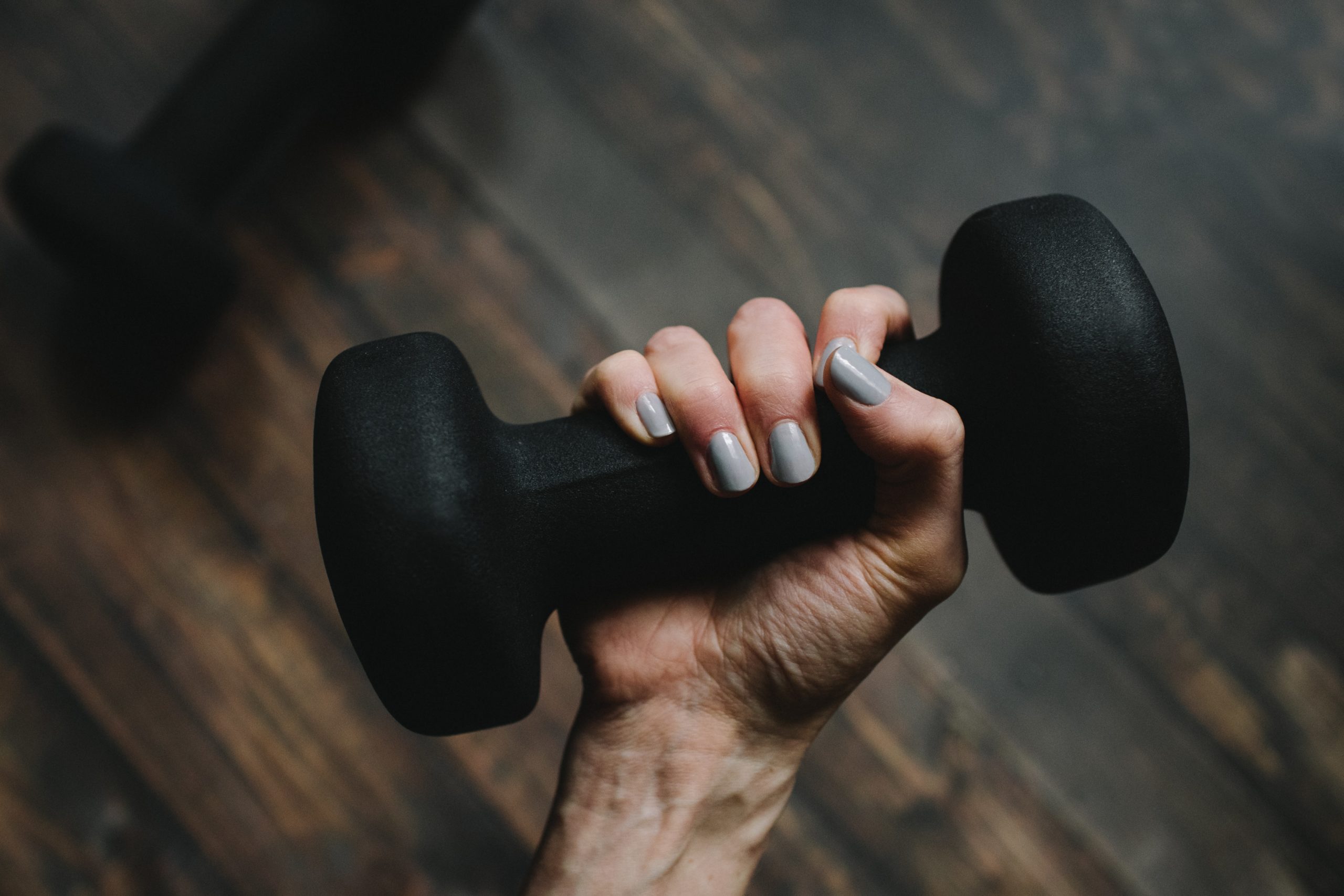Any form of exercise is better than no exercise. But resistance training has some unique benefits that are hard, if not impossible, to get from any other type of physical activity.
Not only does resistance training build and maintain lean muscle mass, which plays a huge part in fat loss, healthy weight management, and metabolism. But with the added benefits of improved strength and bone health, resistance training is crucial for longevity, overall health, and, as we age, maintaining independence.
Resistance training doesn’t have to require any expensive equipment or unique clothes. If you don’t want to pay for a gym membership, you can easily do your workouts in the comfort of your own home, with minimal equipment.
This article will cover everything you need to know about making the most of your workouts so you can start seeing results in the shortest time possible, even if you only have 30 minutes to spare.
What to Focus on When You’re Just Getting Started
Start by learning the basic movements, hone in on the technique, and gradually increase the intensity as you feel more confident about your abilities. All of that will help you develop a good foundation for years to come.
As with any new activity, listen to your body and take breaks when needed. If an exercise causes pain, stop and consider modifying the workout. Finally, warm up before your training session, as this will help reduce the risk of injury. This means stretching, doing a light jog or brisk walk, and/or doing some of the exercises in your routine, but with either less resistance or none at all.
The Equipment You Need to Get Started
The great thing about resistance training is that you don’t need much equipment to get started. All you need are comfortable clothes, a pair of trainers (feel free to go barefoot at home), and an exercise mat. But to really take things to the next level, you will definitely want to get at least one of the following: dumbbells, barbells, kettle bells, or resistance bands.
The program we’ve outlined uses only dumbbells. You can swap dumbbells for kettlebells if that’s what you already have. Or you can find either one in your local sports store or online.
Warming Up for Resistance Training
The goal of the warmup goes beyond just warming up the muscle. You’re also warming up the joints and preparing your mind and nervous system for the workout. If you’re pressed for time, you could take the exercises in your strength workout and do 1 to 3 sets on each, gradually increasing the weight.
Alternatively, you can choose a variety of movements that complement your strength workout. We’ll cover a more comprehensive full-body warm-up as a part of the workout later on.
Choosing the Right Resistance Exercises
Focus on compound, multi-joint exercises that use multiple muscle groups at once. For example, instead of focusing on smaller isolated movements like bicep curls and tricep extensions, do upper body rows, deadlifts, or bench presses. These cover not only your biceps and triceps but also the upper back and chest.
Using compound exercises allows you to save time by doing fewer exercises, and you will trigger a more significant hormonal response from your body. This will ensure you see better improvements in your strength and lean muscle gains.
Choosing the Ideal Number of Sets and Repetitions
Most workout programs revolve around sets and repetitions. A set is a group of consecutive repetitions of an exercise. The number of repetitions you should do in each set depends on what you want to achieve with your workouts.
8-12 repetitions of each exercise is a good number for general strength, lean muscle building, and bone health benefits. For most exercises, doing two or three sets is a good start for beginners. You can start doing 4-6 sets as you become more advanced.
As your training increases, you need to increase the total training volume (combination of sets and repetitions) to keep progressing. At that point, you may opt to work up to four or even six sets.
Ultimately, figuring out exactly how many sets and reps are perfect for you will come down to trial and error. Some people do better with less overall volume; others need more.
The most important thing to remember, is it really isn’t about how many sets or reps you are doing. What matters most is that you are working out the targeted muscle effectively. The harder you work out, the higher the likelihood you will achieve muscular hypertrophy (taring your muscle fibers so they have to repair and grow). You can accomplish that with a low or high number of reps, you just need to make sure you are working out until failure.
Another good rule of thumb to keep in mind – the more reps you do, the more calories you are likely to burn.
Choosing the Correct Weights
The weights matter less than finding the right intensity (the challenge level of the exercise). Going near failure is the priority of any successful training program. You must take sets near failure to reap the benefits of resistance training.
For best results, take each set within 1-2 reps of failure, regardless of the weight. If you can do 10 repetitions, stop at rep 8 or 9. If you can do 15 repetitions, stop at around rep 13 or 14.
As your training level increases, you can take more sets closer to failure as long as you still finish each set with perfect form. The final rep of the set should look as good as the first rep.
Resting between the sets
Aim for at least 90% recovery. Instead of doing a set of an exercise and waiting to do another set of the same exercise, combine two or more non-competing exercises in a superset to save time:
Train your legs with a set of squats, and while your legs rest, train your upper body with a set of rows. Then do another set of squats while your upper body rests.
Supersets reduce your rest periods to 45-60 seconds between sets. Your weights are too heavy if you need >90 seconds between sets. If you’re resting for less than 45 seconds, you’re likely using weights too light.
Regardless of your rest periods, always listen to your body and take a more extended break when needed. Rest is just as important as the actual exercise. If you’re returning to each set with too little rest, you cannot challenge your muscles enough and force them to adapt to the training stimulus.
Option 1: A Simple Beginner Workout
This a simple 30-minute workout you can do at home with 15lb or 20lb dumbbells.
Warm Up / Movement Prep (6min)
- A1 Downward dog to step and rotation x 3 reps per side
- A2 Squat to stand x 5 reps
- A3 Lateral lunge to overhead drive x 3 reps per side
- A4 Standing cross crawl x 20 steps
- A5 Suitcase carry x 20 steps side
Complete all exercises in a circuit. Do all the repetitions for A1, followed by the repetitions for A2, and so on. Complete as many circuits as you can in 6 minutes. Keep the intensity at around 6-7 out of 10.
Strength Superset A (12min)
- A1 Goblet squat x8-10
- A2 1-arm dumbbell/kettlebell row x8-10 per side
Strength Superset B (12min)
- B1 Dumbbell deadlift x8-10
- B2 Push up* x8-10 per side
*If you can’t do full push ups, you can do them against a chair, plyobox, or a wall. For a more challenging version, try doing decline push ups, archer push ups, or close grip push ups.
Option 2: A Beginner Calisthenics Workout
If you don’t have weights and don’t want to join a gym, you can still get a great workout by using your body weight as resistance.
Warm Up / Movement Prep (6min)
Same as in the Option 1.
Strength Superset A (12min)
- A1 1-Leg squat or a sissy squat x8-10
- A2 Bodyweight rows, aka Australian pull up – use a sturdy table or a door frame x8-10 per side
Strength Superset B (12min)
- B1 Split squat with a forward lean x as many good reps as possible
- B2 Push up in a downward dog* x8-10 per side
*Finding any bodyweight shoulder exercises can be challenging when just starting out. This one targets more shoulders compared to the traditional push up. If you find it too difficult, lower your hips.
Don’t Rush Between Sets of Strength Work
The goal is to do a strength workout, not high-intensity cardio. Never lose your form, even if you can’t complete the prescribed rep range. Only good-quality reps count.
Most of the time, keep the intensity at around 7-9 out of 10. Some days go easier and occasionally go harder. Never judge progress based on any one workout.
Do 2-3 workouts a week, ideally resting 36-48 hours between workouts. You can either alternate between Option 1 and Option 2 or stick with just one.
How to Make Sure You’re Progressing
You can progress by modifying the intensity (resistance/weight), the volume (total of reps and sets), or the time (doing more or the same volume/intensity in less time).
Avoid changing all three variables at once. Instead, choose one thing to modify at a time.
You Can Select Any of the Following Ways to Progress From Workout to Workout
- Keep the weight the same and try to add a repetition.
- Keep the weight and the reps the same, and add a set.
- Keep the weight, the reps, and the sets the same, but try to get it done in less time.
- Keep the reps and the sets the same and increase the weight.
You can also progress by using something called ‘constant resistance strength training’. Keep the weight, the reps, the sets, and the time the same until the workout feels easier. Then adjust one of the variables and start again.
Should You Progress in Each Workout?
In the beginning, progress happens quickly. This honeymoon period can last up to a year, or more. You can try to make little progress in most workouts provided that you’re not forcing reps, feeling excessively sore, or struggling to recover between workouts.
But it’s unreasonable to expect to progress in every workout. An excellent general rule to keep in mind is that some workouts are bad, very few are amazing, and most land somewhere in the middle. It’s the consistency over time that matters.
The Training Frequency for Best Results
Two challenging 30-minute sessions a week are enough for non-athletes to get the strength, lean muscle, and bone density benefits. That said, 3 x 30 minutes will likely give you better results as you can get more work done.
You don’t get the resistance training benefits in the workout, but by recovering from it. So more isn’t always better.
How Often Should You Change Exercises?
In terms of progress, as long as you’re seeing improvement and adjusting for the variables mentioned earlier, there’s no reason you need to change exercises. But, it’s often the boredom that gets in the way. Switching an exercise or two every 4-6 weeks works best for most people to keep things interesting.
Cardio for Beginners
Unfortunately, you will not get any cardio benefits by just doing weights. Here are the beginner’s guidelines for cardio:
If you have low cardiovascular fitness, increase your daily physical activity by going for moderately paced walks, bike rides, or similar. A good intensity to aim for is 6-7 out of 10. It’s enough to still maintain a conversation. If you’re tracking your heart rate, aim for 65-70% of your heart rate max (220 – your age x 0.65 and 0.70). This type of cardio is often referred to as Zone 2 training.
In general, any amount is better than none. But there are plenty of long-term metabolic health benefits you’ll start getting at around the 45-minute mark of the moderate-intensity cardio session.
If you can do >45 minutes each time, go for it. But that’s only feasible sometimes, so just start with the time you’ve got. Depending on your preference, you can do these cardio workouts in a gym or outside.
As your fitness improves, you can add moderately challenging intervals at the end of your strength workouts. Aiming for a 1:4-5 work: rest ratio. For example, if your interval effort is 10 seconds, rest for 40 or 50 seconds before going again.
A reasonable beginner interval to aim for is between 10-30 seconds. These intervals shouldn’t be an all-out effort. But, like with the resistance training, somewhere around 7-9 out of 10. Start with 2-4 intervals and build to 10 over time.
The Ideal Frequency for Cardio
For Zone 2 cardio, volume is your friend. There’s no upper limit on how long you can go or how often you should do it—provided that you’re feeling good and don’t need days to recover.
As for the intervals, start with one session a week and increase to two as your fitness improves. Most people like to do interval training at the end of the strength workouts for time efficiency. But you can also do them on non-strength training days. In this case, complete the strength workout warm-up before starting.
How to know if you should do cardio before or after your workout? It really is preference, but consider these two points: (1) If you are working out in the gym, people might not want your sweaty cardio body all over the equipment (2) Research has shown that doing cardio after your workout can help flush out lactic acid (make you sore).
What to Expect in Terms of Results
An increase in energy and mood are often the first signs people comment. Both of those benefits are almost immediate. If you work out with the right intensity and frequency (as outlined in this blog), you should start feeling better and stronger after just a few sessions.
The visible results depend on the time, effort, and consistency you put into your workouts. Generally speaking, it usually takes a few weeks of consistent training before any visible changes happen. And your diet, sleep and stress management play a big part in your progress. Having a cheat meal is fine, but a complete cheat day might throw you off.
The best advice here is to be patient and stay consistent. Consistent work pays off, so take it one session at a time, and don’t let temporary frustrations derail your progress.
With dedication, you should start experiencing results within the first few weeks.
Zoppler is reader supported and may earn affiliate commissions from links on this page. We support and believe in all the products and services we promote and are affiliated with.











